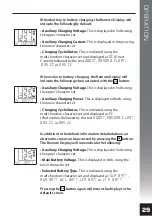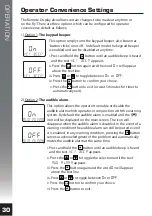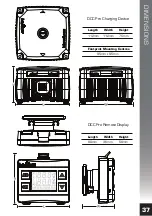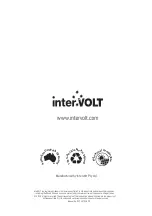
APPENDIX
39
Ignition control mode:
In ignition control mode the system is controlled
differently because the operator is effectively directing the function of the
device when they turn the key on or off. In this mode the DCC Pro has two
optional settings. These settings allow the DCC Pro to be used in traditional
vehicles with conventional charging methods or the new ECU controlled
systems used in modern design. The NORMAL setting is provided for the former
and the LOW for the latter. In ignition mode the start-up Voltage is the same
value in both NORMAL and LOW settings and is set to 12.8V (remember this is
the Voltage level of the main battery). In order to conserve power, the DCC Pro
will NOT commence charging, even with the ignition ON if the main battery has
a Voltage level below 12.8V. The difference between the settings is the low
Voltage cut-out limit. These limits are set as follows:
1. NORMAL: 12.0VDC
2. LOW: 11.5VDC
If the main battery falls below these levels the DCC Pro will stop charging
immediately in order to protect it from further discharge.
CHARGING METHODS
Boost/CC:
The boost/CC stage (also known as bulk charge) is the stage when
the Charging Device is operating in constant current mode. In CC mode is
producing the heavy current required to re-charge a depleted battery as quickly
as possible. The boost/CC Voltage is determined by the battery type selected in
the initial set-up phase. The boost/CC stage is controlled by an algorithm of
time vs Voltage to ensure that the battery is charged optimally under the given
conditions. In boost/CC stage the charger will produce up to 25 Amps
(maximum) subject to the aforementioned conditions. When the Charging
Device is powered up and the auxiliary battery measures 12.6V or below the
boost/CC stage is then initialised. At this point the ‘soft start’ function is also
enabled (see page 38 for detailed information) and current flows. The boost/CC
stage is completed or terminated under the following conditions:
•
when the auxiliary battery reaches terminal Voltage
(pre-determined by the battery type selected) ; or
•
the maximum boost/CC time has expired before the
battery has reached terminal Voltage.
In the instance where the boost/CC time has expired before reaching terminal
Voltage, the charging process will skip the next (absorption/CV stage) and
progress directly to the final (float) stage. Generally this occurs when the
auxiliary battery is damaged or no longer serviceable.
Continued...


















